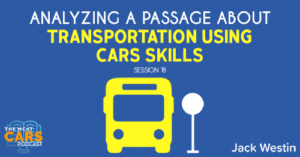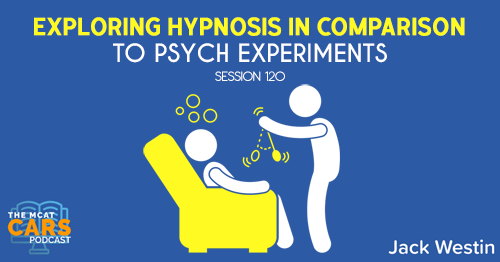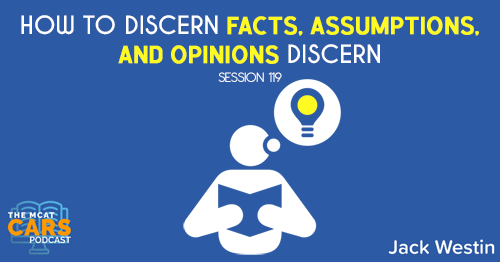Apple Podcasts | Google Podcasts

Session 18
In today’s article, we use Jack Westin’s MCAT CARS techniques to analyze why the US public transportation system is different and why it is needed in society.
Link to article:
“When it comes to the quality of public transit, comparisons between American cities and international counterparts are usually met with a simple response: “It’s different over there.”
These differences, the argument goes, are vast and fundamental: Europe is far more densely built, and its older cities—settled centuries before the automotive age—will always be innately transit-friendlier. In Asian cities, meanwhile, explosive urban growth has been accompanied (and accelerated) by massive government investments in urban rail networks. But the U.S. boomed in the 20th-century’s automobile age, and the private car is still king; most American cities and their suburbs are utterly dependent on them.
How did transit become such an afterthought in Americans’ transportation habits? I addressed that question in detail in an earlier CityLab piece. But to briefly summarize: Transit everywhere suffered serious declines in the postwar years, the cost of cars dropped and new expressways linked cities and fast-growing suburbs. That article pointed to a key problem: The limited transit service available in most American cities means that demand will never materialize—not without some fundamental changes.
The U.S. did see a resurgence of transit spending on big projects in the 1960s, ‘70s, and ‘80s. But there was a big difference between America’s approach to big urban metro projects and that of Canadian and European cities: Even when the United States built expensive rail systems, it never took care of the basics. Cities rarely provided good, frequent local connections that allowed people to actually get to rail stations without walking or driving. To this day, in most parts of American cities, it is all but impossible to get anywhere on a Sunday at 8 p.m. by transit, and if you miss the bus you might be waiting an hour or more for the next one. Such a situation is virtually unheard of in most other developed countries, where even many small villages have a relatively regular bus.
That’s the fundamental problem that makes transit useless for most people in most American cities. The key to great transit service is not about getting 100 percent of people to ride transit for 100 percent of trips. It’s about giving people a viable choice of getting around without needing to drive.
Figuring out how to improve transit isn’t like curing cancer or inventing a quantum computer, either. There are good, viable models of transit systems that already exist in cities that look a lot like U.S ones. They are successful both at attracting riders and at being financially viable, from places that have more in common with American cities than one might expect.”
[03:33] Paragraph 1, Sentence 1:
When it comes to the quality of public transit, comparisons between American cities and international counterparts are usually met with a simple response: “It’s different over there.”
Jack says:
When it says public transit, it could mean so many things – bus rides, trains, taxis, etc – and it probably means many people use.
[04:26] Paragraph 2, Sentence 1:
These differences, the argument goes, are vast and fundamental: Europe is far more densely built, and its older cities—settled centuries before the automotive age—will always be innately transit-friendlier.
Jack says:
Most people would probably assume that older cities have the worst transit systems because transit means using technology to move from one place to another. But that would be the wrong assumption here since they’re telling you it’s friendlier.
The most important thing here is that they’re saying “before the automotive age,” transit is friendlier. So there’s something about the automotive age – cars – that affects public transit in some way. We don’t know how or why but to some degree, it’s detrimental. This is something you have to assume since they’re trying to create that connection here.
[06:05] Paragraph 2, Sentence 2:
In Asian cities, meanwhile, explosive urban growth has been accompanied (and accelerated) by massive government investments in urban rail networks.
Jack says:
Now, they’re bringing up rail networks. They haven’t defined what public transit is until now. So maybe it has something to do with trains. And it’s a fact, Asian countries are investing more.
[06:48] Paragraph 2, Sentence 3:
But the U.S. boomed in the 20th-century’s automobile age, and the private car is still king; most American cities and their suburbs are utterly dependent on them.
Jack says:
So they mentioned Europe and Asia, and now, the U.S., and that American cities are built or dependent on them. It’s not a bad assumption to make that maybe they’re less transit-friendly because they have a lot of automotive stuff going on. But you don’t need to make that assumption. At this point, all you need to know is that there’s a difference between the American public transit system and the other countries.
[07:45] Paragraph 3, Sentence 1:
How did transit become such an afterthought in Americans’ transportation habits?
Jack says:
The author is saying this in an argumentative way. By suggesting “how,” the author is implying that this is the case. But maybe it’s not the case. Maybe America does value transportation or transit. So it’s interesting how the author decided to just automatically tell us that Americans don’t care about the transit system. And now, it’s asking us why.
For whatever reason, you have to know that the author believes America is backtracking or is not progressive in terms of transit. That is established as a hard assumption at this point. However, the reason is not clear.
[09:30] Paragraph 3, Sentences 2-3:
I addressed that question in detail in an earlier CityLab piece. But to briefly summarize: Transit everywhere suffered serious declines in the postwar years, the cost of cars dropped and new expressways linked cities and fast-growing suburbs.
Jack says:
So the author is saying the reason as to why we’re using more cars. And that’s because it’s cheaper.
[10:12] Paragraph 3, Sentence 4:
That article pointed to a key problem: The limited transit service available in most American cities means that demand will never materialize—not without some fundamental changes.
Jack says:
The fact that we don’t have many of them limits us. People don’t even think about them. The demand will never increase simply because we have cars. And really, it’s because we don’t have that many to begin with.
[11:05] Paragraph 4, Sentence 1:
The U.S. did see a resurgence of transit spending on big projects in the 1960s, ‘70s, and ‘80s.
Jack says:
This is the confusing part for most students when you see something and then it automatically contradicts itself. But remember that this is the first sentence of the paragraph and the author is most likely trying to transition into either discussing something else without this topic or further elaborate on why it’s limited. To seem less bias, the author is trying to say that at some point there was an increase. But don’t be surprised if in the next sentence, the author goes back to the initial idea or argument that we’re still limited.
The trick here is to figure out what side the author keeps talking about and that’s the side the author is on. They might point onto the other side but the author will always come back to the initial side that they really cared about.
[13:10] Paragraph 4, Sentence 2:
But there was a big difference between America’s approach to big urban metro projects and that of Canadian and European cities: Even when the United States built expensive rail systems, it never took care of the basics.
Jack says:
The use of contrast words like “but” is a common theme on the MCAT. This gives you a lot of indication about what the author really likes and believes. The idea that usually comes out after the contrast word is the idea the author cares about. The author really wants you to know that point of view. However, this may not always be the case. So you still have to read and understand what you’re reading.
But usually, contrast words denote that the author is going back to their initial argument that they really cared about.
[14:30] Paragraph 4, Sentence 3:
Cities rarely provided good, frequent local connections that allowed people to actually get to rail stations without walking or driving.
Jack says:
The author is pointing out what the basics are and stating that it didn’t happen that’s why we’re struggling.
[14:48] Paragraph 4, Sentence 4:
To this day, in most parts of American cities, it is all but impossible to get anywhere on a Sunday at 8 p.m. by transit, and if you miss the bus you might be waiting an hour or more for the next one.
Jack says:
This is another example of our failures. And this is the limiting factor on why demand will never increase because the basics are not there.
[15:13] Paragraph 4, Sentence 5:
Such a situation is virtually unheard of in most other developed countries, where even many small villages have a relatively regular bus.
Jack says:
The author gives a comparison here again between the U.S. and other countries.
[15:37] Paragraph 5, Sentence 1:
That’s the fundamental problem that makes transit useless for most people in most American cities.
Jack says:
The fundamental problem is that you can’t just get anywhere at 8 pm and if you miss the bus, you’re going to be waiting. You have to walk or drive somewhere to get to another train station.
[16:04] Paragraph 5, Sentence 2:
The key to great transit service is not about getting 100 percent of people to ride transit for 100 percent of trips.
Jack says:
The author is saying that it’s not about everyone riding a transit system. And that goes back to availability. The author is trying to point that it’s about availability, whether or not it’s easily accessible.
[16:35] Paragraph 5, Sentence 3:
It’s about giving people a viable choice of getting around without needing to drive.
Jack says:
The author is just finishing this off with their perspective on what would make a good transit system – just giving people the choice whether to drive or take a bus or train.
The big picture of this passage is a neutral response to this idea of how there isn’t much transit going on in America because of the automotive argument. Knowing the basics and the reasoning behind is very important. So the reasoning here is the automotive part, but also, accessibility.
Link to article:
SEARCH SITE
SEARCH SITE
LISTEN FOR FREE











